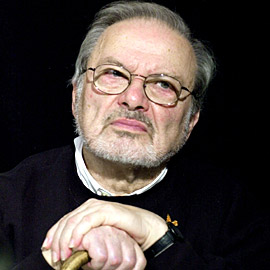Maurice Sendak Profile Biography. Maurice Bernard Sendak (born June 10, 1928 in Brooklyn, New York) is an author and illustrator of literature for children and youth, famous for his album Where the Wild Things, published in 1963.
Maurice Sendak Career History
Born into a family of Polish Jewish immigrants, Maurice Sendak grew up in Brooklyn, New York. Sickly child, Sendak decided to become an illustrator for children under the influence of the Disney movie Fantasia at the age of twelve. His drawings were first published in a history book of 1947 titled Atomics for the Millions, and he spent the years 1950 to make a name as a prolific artist of children's books.
 |
| Maurice Sendak Photo |
He met international success with the Wild Things Are (Where the Wild Things Are), although the representations of monsters with sharp teeth worried parents at the album's release. Sendak's attraction to the dark side, transgressive, nightmare of childish imagination made him a controversial issue in some countries. Psychoanalysts such as child specialists Dolto in France were first recommended this album. Sendak lived since 1957 with a psychoanalyst Eugene Glynn, who remained his companion until his death in 2007.
His album unavoidable, 1970, the Night Kitchen (In the Night Kitchen) has consistently been censoring because it shows pictures of a baby boy frolicking naked in all innocence throughout the story, the book was banned in several countries, and a rumored elsewhere it has been retouched and edited with the young hero of long layers.
However, this is an urban legend. (Night Kitchen regularly appears on the list of "books most frequently challenged and banned" from the American Library Association, including a 25th place on the "100 most challenged books of 1990-2000.") . Yet the album is a real tribute to Winsor McCay famous American designer. Indeed, we find the style of his cartoons and illustrations in the layout of the album very close to the comic strip "Little Nemo."
In the 1970s, along with his creations and his illustration work, Maurice Sendak diversifies and starts making stage sets.
Sendak produced a television adaptation of his work in animation called Really Rosie Carole King, who was released in 1975. He adapted his book Where the Wild Things Are for the theater in 1979. It also illustrates the tales of the Brothers Grimm, Randall Jarrell, Robert Graves, and George MacDonald, and The Horn wonderful children.
He designs the scenery of many operas and ballets, including the representation of prices covered Nutcracker Tchaikovsky by Pacific Northwest Ballet (1983), the performances of The Magic Flute (1981) by the Houston Grand Opera and Hansel and Gretel by Humperdinck (1997), the representation of Mozart's Idomeneo by the Los Angeles County Music Center's 1990 and the performance of The Cunning Little Vixen by Leoš Janáček by the New York City Opera in 1981.
In the 1990s, Sendak is for the playwright Tony Kushner to write that a new English version of the children's opera by the Czech composer Hans Krása, Brundibar. Kushner wrote the text for Sendak illustrated book of the same name, published in 2003. The book is among the 10 best illustrated books of the year in The New York Times Book Review.
In 2003, the Opera Theatre of Chicago represented the adaptation of Sendak and Kushner Brundibar. In 2005, the Berkeley Reparatory Theatre, in collaboration with the Yale Reparatory Theater and the New Victory Theater deBroadway, represents a greatly revised version of the same adaptation.
He illustrated the series of Little Bear Else Holmelund Minarik, who also became an animated series for television. A feature film based on Where the Wild Things Are was released in 2009, directed by Spike Jonze on a screenplay by Dave Eggers, Michael Goldenberg and Jonze: Where the Wild Things (film).
No comments:
Post a Comment